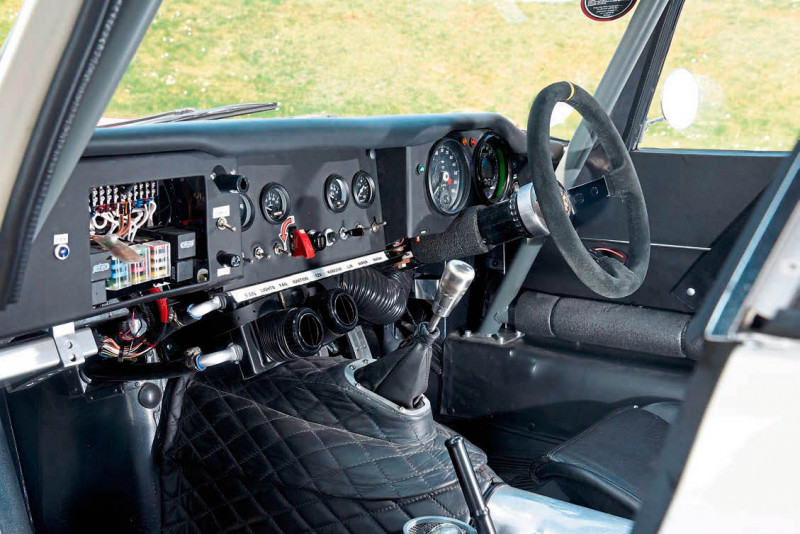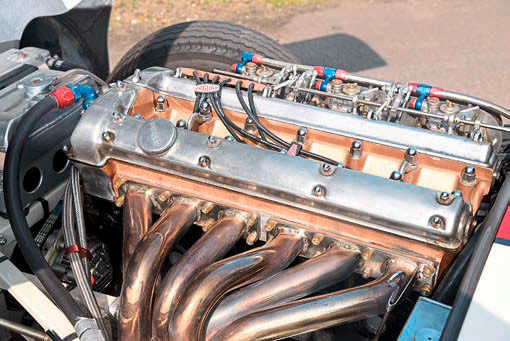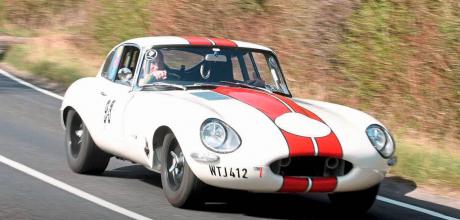Modified 1969 Jaguar E-type Series 2 Lightweight and made for sprints
Wanting an E-type for sprints and hill climbs, Darren Tyre has transformed a lowmileage Series 2 fixedhead coupe into a fast, unique and well-developed racer. Words & Photography Paul Walton.
SPRINT FINISHMODIFIED E-TYPE SERIES 2
Lighter, stiffer and with more power, this fixedhead coupe could easily be a genuine Lightweight but was actually transformed over three years by just one man and at home
Following a 200bhp Ford Zetec-powered Austin-Healey ‘Frogeye’ Sprite a 200mph Ultima GTR and a Lotus Elise (with which he won the Sevenoaks & District Motor Club’s Rose & Crown Sprint Trophy), Darren Tyre is no stranger to fast, exotic and left-of-centre cars. But neither is he to more traditional models having owned a 1964 E-type fixed-head coupe for 20 years. In 2014 he decided to bring these two interests together to create an E-type modified specifically for sprints and hill climbs.

The catalyst was, in his words, a “well-put-together E-type” he saw at that year’s Le Mans Classic and wanting to do something similar. “I had an Ultima GTR at the time which I’d already owned for five years. I thought, ‘I’ve done the 200mph thing; it’s time to move on.’”
With so much torque, it seems to keep pulling forever
After deciding against using his existing E-type, since as Darren says, “I didn’t want to tear down such a good original car and anyway, having two E-types in the garage isn’t such a bad thing,” the first task was sourcing a suitable donor. In mid 2014 he found a recently imported, left-hand-drive, one-owner 1969 fixedhead coupe that had a documented 18,000 miles on the clock. Yet despite its lack of mileage and being an ex-Florida car, the floors were still rusty and so his first task was to get the body right.

Having built and modified several other cars in the past, including that Zetec-powered Frogeye – his skills helping him find a job at marque specialist, E-type UK, as one of its restoration technicians in late 2019 – Darren did much of the work himself in his home garage. Starting with the body, he braced the shell and welded in a new floor, new inner and outer sills plus extra strengthening behind the seats. He then fitted a full FIA-specification, eight-point rollcage and added a harness bar. Finally, he cut both rear quarters off before adding wider rear wings that were handmade by RJ Panels Ltd that also supplied a new bonnet, doors and tailgate all in aluminium. “Laser levels were my friend,” remembers Darren about how he made everything fit. “I made datum points before cutting anything to check it was all straight.”
Since Darren wanted this Series 2 to look like the first generation of E-type, he specified a Series 1-style of bonnet plus he fitted an appropriate rear numberplate holder sourced from a Jaguar parts specialist as well as all the correct lights. Other body modifications included a driver’s sidekick panel for the front and rear brake master cylinders, while the clutch master cylinder now comes through from the aluminium pedal box.
Darren then prepared and painted the shell himself. Choosing the tricky-to-apply clear over base system, he decided to replace the original Willow Green with white, finished with two broad red stripes from carwrap specialist, Creative FX.
“I was originally going to do it red to match my other E-type and Frogeye,” he says. “But when I went to the Spa Six Hour Classic I saw an E-type in the same colours and liked it.”
It’s when Darren tells me about the windows that I begin to understand the lengths he’s gone to in pursuit of perfection and for the car to be as light as possible. “The side and rear windows are made from polycarbonate,” he tells me, “while the screen was made by Pilkington and is 1mm thinner on each laminate to make it lighter.” I doubt even touring car teams go to such precision.
He then swapped the car from left to right-hand drive before constructing his own dashboard and door panels from aluminium while the seats are from a Lotus Exige.
Finally, the headlining is lightweight Corex sheeting covered in Alcantara.
After the original 4.2-litre engine had been rebuilt by respected XK specialist, VSE, to its fast-road spec, Darren then added triple Weber carburettors plus an Omex 710 ECU to control the ignition which is integrated into the car’s electrics via a custom-made loom. To keep it cool, there’s an aluminium radiator and header tank plus a 16in fan.
There’s also a control switch to stop the engine from revving beyond 3,000rpm until the temperature is up to 60degC. The gearbox is a Tremec T5 and Darren also added a line lock for warming the rear tyres while stationary at speed events.
The rear axle is mounted on uprated mounts with polyurethane-bushed radius arms while the suspension consists of Gaz aluminium-bodied shock absorbers with 30/90 assistor coilover springs on the front shocks plus an adjustable reaction plate from Rob Beere Racing.
Only working on the E-type at weekends and evenings, it took Darren a gruelling three-and-a-half years to finish the project, but when I see the car for the first time it was clearly worth all the effort. Together with its wider rear arches and huge Dunlop Peg Drive rims (7x15in at the front and 8x17in at the rear) the car has an aggressive stance most other modified E-types could only dream of. When I say to Darren it could pass for a genuine Lightweight, he laughs and says at £75k (which included £13,500 for the car) it didn’t cost anywhere near what they’re worth to complete.
I’m both honoured and excited when Darren offers me a drive and I soon get comfortable behind the wheel, largely due to the seats. Unlike some modified specials I’ve driven that have eye-wateringly tight competition buckets, with these coming from a Lotus Exige road car they’re not too restrictive yet still do a sterling job of holding me in place, the racing harness taking care of any movement.
Although Darren made the dash himself, by keeping to the same contours as the original plus using traditional-looking but modern white-on-black dials it doesn’t immediately look new. Plus, by placing the small yet accurate digital speedo in the centre of the original dial, it isn’t immediately noticeable either.
The ignition button is hilariously marked ‘KABOOM’ on the fascia, a perfect description of the noise the 4.2-litre engine makes when it bursts angrily into life. Fighting the desire to use the line lock to lay down some rubber, after I release the hydraulic handbrake (again fitted to save weight) and click the Tremec ‘box into first, the car moves surprisingly easily.
But after more than a little encouragement from Darren, when I squeeze the throttle hard, the engine responds instantly. With so much torque, it seems to keep pulling forever until finally the rev-counter needle starts to dance around the red line and I quickly snatch second and then third. I can well believe it when over the noise Darren tells me his E-type has been timed at reaching 60mph in a mere 5.9 seconds and has a top speed of 157mph. In other words, this 53-year-old car is now as fast as a current F-TYPE 2.0 Coupé.
Although the front brakes use four pot calipers and vented discs from Zeus Engineering plus rebuilt Series 2 calipers on grooved discs at the rear, since both ends use competition-style Yellowstuff performance brake pads, Darren warns me they need to be warm to be properly effective. And sure enough, as I approach a corner the pedal needs pressing hard although the more miles I do the better they become.
By weighing a mere 1,156kg (around 200kg less than a standard Series 2 FHC) together with the 49/51 weight distribution, the car feels faster and more agile than any other E-type I’ve driven.With sharp steering, little body roll due to the stiffened suspension plus the fat Avon tyres finding plenty of grip, I can press surprisingly hard through bends before nailing the throttle on the exit, the cabin again filled with the deep yet melodic growl of the XK unit.
After completing the car in August 2019, Darren has already competed in the car a few times including at the Brighton Speed Trials, Crystal Palace’s Motorsport at the Palace event and the E-type 60 weekend held at Shelsley Walsh when he finished a commendable third. “I was chuffed about that since the two ahead of me were on slick tyres and knew the place.”
Yet what I like most about Darren’s car is its dual personality. It may have released the E-type’s inner racer but it hasn’t totally lost its character and remains relatively usable. Plus, if you’re going to change what is arguably the most beautiful car in the world it has to be done well. And thanks to his experience with both E-types and modified cars, that’s exactly what Darren has done.
Thanks to: Darren Tyre
FROM TOP: The car as Darren bought it, still in its original Willow Green and hiding plenty of rust; Back in Darren’s garage, the three and- a-half-year process to transform to a sprint car could begin; Darren started with the body including adding a rear numberplate panel from a Series 1.


